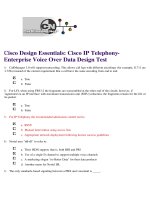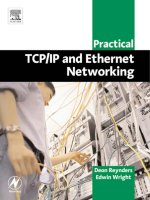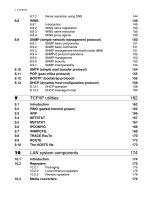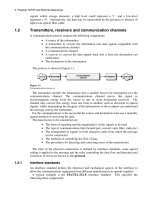DELTA IA PLC ethernet IP OP EN
Bạn đang xem bản rút gọn của tài liệu. Xem và tải ngay bản đầy đủ của tài liệu tại đây (3.09 MB, 128 trang )
Industrial Automation Headquarters
Delta Electronics, Inc.
Taoyuan Technology Center
No.18, Xinglong Rd., Taoyuan City,
Taoyuan County 33068, Taiwan
TEL: 886-3-362-6301 / FAX: 886-3-371-6301
Asia
Delta Electronics (Jiangsu) Ltd.
Wujiang Plant 3
1688 Jiangxing East Road,
Wujiang Economic Development Zone
Wujiang City, Jiang Su Province, P.R.C. 215200
TEL: 86-512-6340-3008 / FAX: 86-769-6340-7290
Delta Greentech (China) Co., Ltd.
238 Min-Xia Road, Pudong District,
ShangHai, P.R.C. 201209
TEL: 86-21-58635678 / FAX: 86-21-58630003
Delta Electronics (Japan), Inc.
Tokyo Office
2-1-14 Minato-ku Shibadaimon,
Tokyo 105-0012, Japan
TEL: 81-3-5733-1111 / FAX: 81-3-5733-1211
Delta Electronics (Korea), Inc.
1511, Byucksan Digital Valley 6-cha, Gasan-dong,
Geumcheon-gu, Seoul, Korea, 153-704
TEL: 82-2-515-5303 / FAX: 82-2-515-5302
EtherNet/IP
Operation Manual
Delta Electronics Int’l (S) Pte Ltd.
4 Kaki Bukit Ave 1, #05-05, Singapore 417939
TEL: 65-6747-5155 / FAX: 65-6744-9228
Delta Electronics (India) Pvt. Ltd.
Plot No 43 Sector 35, HSIIDC
Gurgaon, PIN 122001, Haryana, India
TEL : 91-124-4874900 / FAX : 91-124-4874945
Americas
Delta Products Corporation (USA)
Raleigh Office
P.O. Box 12173,5101 Davis Drive,
Research Triangle Park, NC 27709, U.S.A.
TEL: 1-919-767-3800 / FAX: 1-919-767-8080
Delta Greentech (Brasil) S.A.
Sao Paulo Office
Rua Itapeva, 26 - 3° andar Edificio Itapeva One-Bela Vista
01332-000-São Paulo-SP-Brazil
TEL: 55 11 3568-3855 / FAX: 55 11 3568-3865
Europe
Delta Electronics (Netherlands) B.V.
Eindhoven Office
De Witbogt 20, 5652 AG Eindhoven, The Netherlands
TEL : +31 (0)40-8003800 / FAX : +31 (0)40-8003898
IA-0269420-02
*We reserve the right to change the information in this manual without prior notice.
2017/03/31
www.deltaww.com
EtherNet/IP Operation Manual
Revision History
Ve r s i o n
st
1
2nd
Revision
The fir st version was published.
1 . I n f o r m a t i o n c o n c e r n i n g AH C PU 5 X 1 - E N i s a d d ed i n
section 1. 3.1.
2 . I n f o r m a t i o n c o n c e r n i n g AH C PU 5 X 1 - E N i s a d d ed i n
section 2. 1.
3 . I n f o r m a t i o n c o n c e r n i n g AH C PU 5 X 1 - E N a n d
AH CP U- ET H N- 5 A i s a d d e d i n c h a p t er 3 .
4 . I n f o r m a t i o n c o n c e r n i n g AH- RT U s er i e s i s a d d ed i n
section 4. 4 and 4. 6.
5 . I n f o r m a t i o n c o n c e r n i n g TAG i s a d d e d i n s ec t i o n 5 . 1 a n d
5. 2.
6 . I n f o r m a t i o n c o n c e r n i n g AH C PU 5 X 1 - E N a n d
AH CP U- ET H N- 5 A i s a d d e d i n c h a p t er 8 .
7. New pr oduct inf orm ation is added in section 9.2.
Dat e
2016/05/20
2017/03/31
EtherNet/IP Operation Manual
Table of Contents
Chapter 1 Product Introduction
1.1
Introduction ...................................................................................... 1-2
1.1.1
EtherNet/IP ................................................................................... 1-2
1.2
Definition........................................................................................... 1-2
1.3
Features ............................................................................................ 1-3
1.3.1 Delta EIP Architecture ......................................................................... 1-3
1.3.2 Product Features ................................................................................. 1-4
Chapter 2 Network Installation
2.1
Network Installation....................................................................... 2-2
2.1.1.
EtherNet/IP Device......................................................................... 2-2
2.1.2.
Network Installaiton ....................................................................... 2-2
2.1.2.1.
Single Port Device...................................................................... 2-2
2.1.2.2.
Dual Port Device ........................................................................ 2-3
2.1.2.3.
EIP Builder Software .................................................................. 2-4
Chapter 3 Product Specifications
3.1
Ethernet Specifications ................................................................... 3-2
3.1.1
AHCPU5x1-EN ............................................................................... 3-2
3.1.2
AH10EN-5A ................................................................................... 3-2
3.1.3
AHRTU-ETHN-5A ............................................................................ 3-2
3.2
Ethernet/IP Specifications ............................................................. 3-3
3.2.1
AHCPU5x1-EN ............................................................................... 3-3
3.2.2
AHRTU-ETHN-5A ............................................................................ 3-4
Chapter 4 EIP Builder
4.1
4.1.1
EIP Builder ..................................................................................... 4-2
Run the EIP Builder ........................................................................ 4-2
i
4.2
Set up the IP Address ..................................................................... 4-4
4.2.1
IP Address Types ............................................................................4-4
4.2.2
Set up the IP Address (Static IP) ......................................................4-5
4.2.3
Set up the IP Address (BOOTP/DHCP) ...............................................4-6
4.2.4
Enable the BOOTP/DHCP Again ....................................................... 4-11
4.3
Network ....................................................................................... 4-13
4.3.1
Scan Network ............................................................................... 4-15
4.3.2
Add devices (Manually).................................................................. 4-18
4.3.3
Create Network ............................................................................ 4-18
4.3.4
Set up the parameters................................................................... 4-19
4.4
Data Mapping ............................................................................... 4-22
4.5
Diagnosis...................................................................................... 4-28
4.6
AH Series – Connect to a RTU module........................................... 4-30
4.6.1
AHCPU5x1-EN Series..................................................................... 4-30
Chapter 5 Programming
5.1.
DFB_EIP_EXP Function Block ......................................................... 5-2
5.1.1 Parameters .........................................................................................5-2
5.2.
TAG Function .................................................................................. 5-7
5.2.1
Produced TAG .................................................................................5-7
5.2.2
Consumed TAG ...............................................................................5-9
Chapter 6 Troubleshooting
6.1
Troubleshooting ............................................................................. 6-2
6.2
Error Code & How to fix them ......................................................... 6-2
6.2.1 Hardware Error ....................................................................................6-2
6.2.2 Configuration Error ..............................................................................6-3
6.2.3 Application Error ..................................................................................6-5
Chapter 7 Studio 5000 Software Operation
7.1
Architecture ................................................................................... 7-2
7.2
Create a New Project ..................................................................... 7-2
ii
7.3
Create a Scanner ............................................................................ 7-4
7.3.1 Create a New Module........................................................................... 7-4
7.4
Connect to a Delta Adapter............................................................. 7-6
7.4.1 Import an EDS file .............................................................................. 7-6
7.4.2 Create an Adapter ............................................................................... 7-8
7.5
Download ..................................................................................... 7-11
7.6
Data Mapping ............................................................................... 7-12
Chapter 8
CIP Object
8.1
Object List ...................................................................................... 8-3
8.2
Data Type ....................................................................................... 8-5
8.3
Identity Object (Class ID: 16#01) .................................................. 8-7
8.4
Message Router Object (Class ID: 16#02) ..................................... 8-8
8.5
Assembly Object (Class ID: 16#04) ............................................... 8-9
8.5.1 AHCPU5x1-EN and AH10EN-5A ............................................................. 8-9
8.5.2 AHRTU-ETHN-5A ................................................................................ 8-11
8.6
Connection Manager Object (Class ID: 16#06) ............................ 8-12
8.7
Device Level Ring Object (Class ID: 16#47) ................................. 8-13
8.8
QoS Object (Class ID: 16#48) ...................................................... 8-16
8.9
Port Object (Class ID: 16#F4) ...................................................... 8-17
8.10
TCP/IP Interface Object (Class ID: 16#F5).................................. 8-18
8.11
Ethernet Link Object (Class ID: 16#F6) ....................................... 8-20
8.12
Vendor Specific Objects................................................................ 8-24
8.12.1 X Register (Class ID: 16#350) ........................................................... 8-24
8.12.2 Y Register (Class ID: 16#351) ........................................................... 8-25
8.12.3 D Register (Class ID: 16#352)........................................................... 8-26
8.12.4 M Register (Class ID: 16#353) .......................................................... 8-27
8.12.5 S Register (Class ID: 16#354) ........................................................... 8-27
8.12.6 T Register (Class ID: 16#355) ........................................................... 8-28
8.12.7 C Register (Class ID: 16#356) ........................................................... 8-29
i ii
8.12.8 HC Register (Class ID: 16#357)......................................................... 8-30
8.12.9 SM Register (Class ID: 16#358) ........................................................ 8-30
8.12.10 SR Register (Class ID: 16#359) ....................................................... 8-31
8.12.11 Control Register (Class ID: 16#370) ................................................. 8-31
8.12.12 Status Register (Class ID: 16#370) .................................................. 8-33
8.12.13 Input Register (Class ID: 16#371) ................................................... 8-34
8.12.14 Output Register (Class ID: 16#372) ................................................. 8-36
8.12.15 RTU AI Register (Class ID:16#373) ................................................. 8-36
8.12.16 RTU AO Register (Class ID:16#374)................................................ 8-37
8.12.17 RTU DI Register (Class ID:16#375) ................................................ 8-37
8.12.18 RTU DO Register (Class ID:16#376) ............................................... 8-38
Chapter 9 Delta EIP Product List
9.1
Delta EIP Products ......................................................................... 9-2
9.2
Delta EIP Products, DLR (Device Level Ring) supported................. 9-2
9.3
Delta EIP Products, Scanner supported .......................................... 9-2
iv
1
Chapter 1
Product Introduction
Table of Contents
1.1
Introduction ...................................................................................... 1-2
1.1.1
EtherNet/IP ................................................................................... 1-2
1.2
Definition........................................................................................... 1-2
1.3
Features ............................................................................................ 1-3
1.3.1 Delta EIP Architecture ......................................................................... 1-3
1.3.2 Product Features................................................................................. 1-4
1-1
_1
Et herNet / I P O perat i on Manu al
1.1 Introduction
1.1.1
EtherNet/IP
EtherNet/IP (“IP” stands for “Industrial Protocol”) is an industrial Ethernet network managed by ODVA, Inc. (formerly Open
DeviceNet Vendors Association, Inc.), a global trade and standards development organization.
EtherNet/IP works on a TCP/UDP/IP based Ethernet network and uses most widely deployed collections of Ethernet
standards to provide a broad range of applications in different industries that require high-speed and stability including
Factory Automation (FA), Building Automation (BA), Process Automation (PA) and many more.
Delta covers a full range of controller and drive products supported by EtherNet/IP, including Programmable Logic
Controllers (PLC), inverters, Human Machine Interfaces (HMI) and so on. Refer to section 9.1 for a full product list
supported by EtherNet/IP. In addition, users can also use the EDS file to connect to the EtherNet/IP devices of other
brands. Delta EtherNet/IP software, the EIP Builder, can be called or run independently through the ISPSoft software.
Download the ISPSoft software at:
/>ownloadID=,&title=--%20Select%20Product%20Series%20--&dataType=8;&check=1&hl=en-US
1.2 Definition
Term
ODVA
Definition
Open DeviceNet Vendor Association for EtherNet/IP
EtherNet/IP, an industrial Ethernet network, provides interoperability for system providers. IP
EIP
stands for Industrial Protocol. The term “EIP” (EtherNet/IP) will be used throughout this
manual.
I/O Connection
Via the I/O connection to connect to EtherNet/IP and to exchange data cyclically.
Connect to EtherNet/IP and to exchange data non-cyclically. Data will be exchanged piece
Explicit Message
by piece via instructions.
Requested Packet Interval, via the I/O connection to connect to EtherNet/IP to exchange
RPI
data at regular time intervals.
ACD
Address Conflict Detection to detect IP address duplications.
TAGs are the methods used for assigning and referencing memory locations for
Rockwell PLCs, the same as the registers for Delta PLCs.
Produced/Consumed
Produced TAG: A TAG that a controller makes available for other controllers. Multiple
controllers can simultaneously consume (receive) the data. A produced TAG sends its
TAG (P/C TAG)
data to consumed TAGs (consumers) without using logic.
Consumed TAG: A TAG that receives the data of a produced TAG. The data type of the
consumed TAG and the produced TAG must be matched (including any array
1-2
Chapt er 1 Pro duct I nt rod uct i on
dimensions).
The data is transferred over Ethernet/IP, for example, PLC-A needs data from PLC-B,
so PLC-B sends the data to PLC-A. Therefore, PLC-A is the producer and PLC-B is
the consumer.
Electronic Data Sheets; EDS files are simple text files used by EtherNet/IP network
EDS
configuration tools to help you identify EtherNet/IP products and easily commission them on
a network.
Data Mapping
Exchange data between devices
EIP Scanner
The master station is called EIP Scanner in EtherNet/IP.
EIP Adapter
The slave station is called EIP Adapter in EtherNet/IP.
Device Level Ring (DLR) provides fault-tolerant network design for daisy-chain and linear
topology. The DLR protocol provides high network availability in a ring topology and was
DLR
intended primarily for implementation in EtherNet/IP end-devices that have two Ethernet
ports and embedded switch technology, providing fast network fault detection and
reconfiguration to support the most demanding control applications.
1.3 Features
1.3.1 Delta EIP Architecture
This typical Delta EIP architecture includes EIP Scanner and Adapter; data mapping can be achieved between devices via
an I/O connection and explicit message.
The AHCPU5X1-EN series which includes AHCPU511-EN, AHCPU521-EN and AHCPU531-EN supports Ethernet
single port communication and for network installation, it is required to employ EtherNet/IP devices.
The AH10EN-5A series supports Ethernet dual port and DLR function; thus it can install, configure, and maintain
linear as well as device-level ring (DLR) networks by using EtherNet/IP devices with embedded switch technology.
1-3
1_
_1
Et herNet / I P O perat i on Manu al
1.3.2 Product Features
Flexibility
-
Flexible topology: EIP devices may include an Ethernet single port as well as Ethernet dual port, and provide
applicable networks such as linear topology, ring topology and ring topology for faster expansion and easier
management.
-
EtherNet/IP works on a TCP/UDP/IP based Ethernet network, uses most widely deployed collections of
Ethernet standards and supports Wifi connection. Even for personnel with no IT background, the network can
still be built up easily.
-
Applicable networks include linear topology, ring topology, star topology, Ethernet, EtherNet/IP, one or more
LANs, etc. Configuration can be set via a USB device or an interface.
Simplicity
-
Via a connector: Delta provides a full range of product line, including human machine interfaces (HMI),
programmable logic controllers (PLC) and inverter drives, for application in an industrial operation. Simply via a
RJ-45 connector, a network can be built up, saving costs on cables and other connecting tools.
-
Single network: In replace with the 3-tier industrial architecture, single network architecture provides
100MB/bits high-speed cyclical and non-cyclical data mapping function, ensuring a complete network diagnosis
and effectively shortening debugging time.
-
Graphical user interface designed software: The EIP Builder is graphical user interface designed for intuitive
operation.
Integration
-
Data mapping: The EIP Builder provides a consistent setting interface, allowing users to reduce the time to
learn and set up configurations easily.
-
Listed device parameters: The EIP Builder presents the device parameters in a list. Instead of looking up in the
user manual, users can quickly check on the parameters in the list.
-
1-4
EDS file: Users can connect to Delta and other brand EtherNet/IP products via the EDS files.
2
Chapter 2. Network Installation
Table of Contents
2.1
Network Installation .......................................................................................... 2
2.1.1
EtherNet/IP Device........................................................................................ 2
2.1.2
Network Installation ...................................................................................... 2
2.1.2.1 Single Port Device........................................................................................ 2
2.1.2.2 Dual Port Device .......................................................................................... 3
2.1.2.3 EIP Builder Software .................................................................................... 4
2-1
_2
Et herNet / I P O perat i on Manu al
2.1
Network Installation
2.1.1
EtherNet/IP Device
A Delta EtherNet/IP (EIP) device allows users to build a linear topology, ring topology, and star topology. A Delta EIP
device includes the EIP Builder software, EIP Scanner, EIP Adapter, EIP Tap, and Ethernet switch. EIP Scanner and EIP
Adapter, each of them can be further divided to a single port and dual port.
Ethernet single port: the AHCPU5X1-EN series which includes AHCPU511-EN, AHCPU521-EN and
AHCPU531-EN.
Ethernet dual port: the AH10EN-5A series
2.1.2
Network Installation
Each EtherNet/IP device is connected to an Ethernet switch via a CAT 5e cable. Please use Delta standard cables and the
DVS series industrial switches. Refer to Delta PLC/HMI Cable Selection Guide for more information.
A single port device can build up a linear and a star topology. An Ethernet switch is required to create a star topology and a
ring topology, and additionally an EtherNet/IP Tap is also needed.
2.1.2.1 Single Port Device
Linear Topology
Linear Topology 1
Linear Topology 2
2-2
Chapt er 2 N et work I n st al l at i on
Star Topology
2.1.2.2 Dual Port Device
A dual port device can build up a linear, star and ring topology. A DLR function is required to create a ring topology. Refer
to section 9.2 for DLR supported series.
Linear Topology
Star Topology
Ring Topology
A DLR function is required to create a ring topology. Refer to section 9.2 for DLR supported series.
2-3
2_
Et herNet / I P O perat i on Manu al
_2
When a switch is needed for topology, the switch should support the DLR function. If not, the connection might fail.
2.1.2.3 EIP Builder Software
Linear and star topology
Install the EIP Builder on your PC to monitor and configure the EIP devices. Users can also connect an EIP device to their
PCs directly or use a switch to connect to the PCs.
2-4
Chapt er 2 N et work I n st al l at i on
Ring topology
Install the EIP Builder on your PC to monitor and configure the EIP devices. Be sure to save a network connection for your
PC to connect to the EIP device.
2_
Or you can use an EIP tap to connect your PC so that the ring topology can stay intact.
2-5
Et herNet / I P O perat i on Manu al
MEMO
_2
2-6
3
Chapter 3 Product Specifications
Table of Contents
3.1
Ethernet Specifications ............................................................................... 3-2
3.1.1
AHCPU5x1-EN ........................................................................................... 3-2
3.1.2
AH10EN-5A ............................................................................................... 3-2
3.1.3
AHRTU-ETHN-5A ........................................................................................ 3-2
3.2
Ethernet/IP Specifications ......................................................................... 3-3
3.2.1
AHCPU5x1-EN ........................................................................................... 3-3
3.2.2
AHRTU-ETHN-5A ........................................................................................ 3-4
3-1
_3
Et h er N et / I P O p er a ti o n Ma n u a l
3.1 Ethernet Specifications
3.1.1 AHCPU5x1-EN
Communication Protocols
EtherNet/IP, MODBUS TCP
Protocols
BOOTP, SNMP, NTP
Communication Speed
10/100 Mbps Auto-Detection
Communication Interface
RJ-45 with Auto MDI/MDIX
Numbers of the Ethernet
Communication Port
1
3.1.2 AH10EN-5A
Communication Protocols
EtherNet/IP, MODBUS TCP
Protocols
BOOTP, DHCP, SMTP, SNMP, NTP
Communication Speed
10/100 Mbps Auto-Detection
Communication Interface
RJ-45 with Auto MDI/MDIX
Numbers of the Ethernet
Communication Port
2
3.1.3 AHRTU-ETHN-5A
Communication Protocols
EtherNet/IP, MODBUS TCP
Protocols
BOOTP, DHCP, NTP
Communication Speed
10/100 Mbps Auto-Detection
Communication Interface
RJ-45 with Auto MDI/MDIX
Numbers of the Ethernet
Communication Port
2
3-2
Chapt er 3 Pro duct Sp eci f i cat i ons
3.2 Ethernet/IP Specifications
3.2.1 AHCPU5x1-EN
Item
General
CIP Network
I/O Connection
Category
Scanner / Adapter
Topology
Star
Max. Number of the CIP
Connections
AHCPU511-EN: 64 (Clients + Servers)
AHCPU521-EN: 128 (Clients + Servers)
AHCPU531-EN: 256 (Clients + Servers)
Max. Number of the TCP
Connections
AHCPU511-EN: 32 (Clients + Servers)
AHCPU521-EN: 64 (Clients + Servers)
AHCPU531-EN: 128 (Clients + Servers)
Requested Packet Interval (RPI)
1 ms~1000 ms
Max. Transmission Speed
AHCPU511-EN: 10000 pps
AHCPU521-EN: 10000 pps
AHCPU531-EN: 10000 pps
Max. Data Length
500 bytes
Class 3 (Connected Type)
Total 32 (Clients + Servers), including the clients +
servers from the UCMM type (for V2.1 or later version)
UCMM (Non-Connected Type)
CIP Network
Explicit Message
CIP Objects
CIP Network
Produced Tag
CIP Network
Consumed Tag
Specification
3_
Total 32 (Clients + Servers) , including the clients +
servers from the Class 3 (for V2.1 or later version)
Identity Object (16#01)
Message Router Object (16#02)
Assembly Object (16#04)
Connection Manager Object (16#06)
Port Object (16#F4)
TCP/IP Interface Object (16#F5)
Ethernet Link Object (16#F6)
Max. Number of the CIP
Connections
32 (Clients + Servers) (for V2.1 or later version)
Max. Data Length
500 bytes
Requested Packet Interval (RPI)
1 ms~1000 ms
Max. Number of the CIP
Connections
32 (Clients + Servers) (for V2.1 or later version)
Max. Data Length
500 bytes
Requested Packet Interval (RPI)
1 ms~1000ms
3-3
Et h er N et / I P O p er a ti o n Ma n u a l
3.2.2 AHRTU-ETHN-5A
Item
General
CIP Network
I/O Connection
_3
Specification
Category
Adapter
Topology
Star, Linear, Ring
Max. Number of the CIP
Connections
96
Max. Number of the TCP
Connections
48
Requested Packet Interval (RPI)
1 ms~1000 ms
Max. Transmission Speed
10000 pps
Max. Data Length
500 bytes
Class 3 (Connected Type)
Total 48 (Clients + Servers), including the clients +
servers from the UCMM type
UCMM (Non-Connected Type)
CIP Network
Explicit Message
CIP Objects
Total 48 (Clients + Servers) , including the clients +
servers from the Class 3
Identity Object(16#01)
Message Router Object(16#02)
Assembly Object(16#04)
Connection Manager Object(16#06)
DLR Object(16#47)
QoS Object(16#48)
Port Object(16#F4)
TCP/IP Interface Object(16#F5)
Ethernet Link Object(16#F6)
Vendor specification object:
Status Register(16#370)
Input Register(16#371)
RTU AI Register(16#373)
RTU AO Register(16#374)
RTU DI Register(16#375)
RTU DO Register(16#376)
3-4
4
Chapter 4 EIP Builder
Table of Contents
4.1
4.1.1
4.2
EIP Builder ................................................................................................. 4-2
Run the EIP Builder .................................................................................... 4-2
Set up the IP Address ................................................................................. 4-4
4.2.1
IP Address Types ....................................................................................... 4-4
4.2.2
Set up the IP Address (Static IP) ................................................................. 4-5
4.2.3
Set up the IP Address (BOOTP/DHCP) .......................................................... 4-6
4.2.4
Enable the BOOTP/DHCP Again .................................................................. 4-11
4.3
Network.................................................................................................... 4-13
4.3.1
Scan Network .......................................................................................... 4-15
4.3.2
Add devices (Manually)............................................................................. 4-18
4.3.3
Create Network ....................................................................................... 4-18
4.3.4
Set up the parameters.............................................................................. 4-19
4.4
Data Mapping ........................................................................................... 4-22
4.5
Diagnosis.................................................................................................. 4-28
4.6
AH Series – Connect to a RTU module....................................................... 4-30
4.6.1
AHCPU5x1-EN Series ................................................................................ 4-30
4-1
_4
Et h er N et / I P O p er a ti o n Ma n u a l
4.1 EIP Builder
Delta EtherNet/IP software, EIP Builder, is embedded in the ISPSoft. It can be called or run independently through the
ISPSoft software (applicable with version 3.0 and later versions). Download the ISPSoft software at:
/>ownloadID=,&title=--%20Select%20Product%20Series%20--&dataType=8;&check=1&hl=en-US
4.1.1 Run the EIP Builder
The EIP Builder can be called from Delta EIP Scanner’s HWCONFIG in the ISPSoft. It can also be called independently to
set up parameters for the Adapter. Delta EIP Scanner is equipped with the EtherNet/IP communication PLC and the
EtherNet/IP module. Refer to chapter 3 for a list of Delta EIP Scanner products supported by the EIP Builder.
4.1.1.1
Run the EIP Builder via an EIP Scanner
Operation Steps
Run the EIP Builder via an EIP Scanner product. When using a Delta EIP Scanner, users need to set up an EIP module
through the HWCONFIG in the ISPSoft.
Start
Open
ISPSoft V3 . 0
Create
ISPSoft Project
Open
HWCONFIG
EIP
P .C
N
Y
Download
H WCON FIG
Open
EIP Builder
Create
EIP Module
1. Open ISPSoft V3.0: Find ISPSoft 3.00 from the start menu in Windows. Click the start menu and go to All programs >
Delta Industrial Automation > PLC > ISPSoft 3.02 > ISPSoft 3.02.
4-2
Chapt e r 4 EI P Bui l der
2.
Create a new project: Click File > New and you will see the Create a New Project window.
3.
Select a PLC: Select a PLC product that supports the EIP builder in the Create a New Project window.
4_
4.
Open the HWCONFIG: Double click the HWCONFIG option under the Project.
5.
Create an EIP module (AH10EN-5A):
Select the AH10EN-5A from the Network Module in the Product List.
Drag the selected AH10EN-5A to the CPU’s main backplane.
4-3
Et h er N et / I P O p er a ti o n Ma n u a l
6.
Save and download the HWCONFIG:Click Save to save the HWCONFIG settings and then click
Download to
PLC to download the file to PLC.
7.
Open the EIP Builder:
7.1 Right-click the AH10EN-5A on the CPU’s main backplane and you will see the EIP Builder. Double click it to
open the EIP Builder.
_4
7.2
Right-click the AHCPU5x1-EN on the CPU’s main backplane and you will see the EIP Builder. Double click it to
open the EIP Builder.
4.2 Set up the IP Address
This section will provide an overview of how to set up the IP address for AH10EN-5A IP and AHCPU5x1-EN. The IP
address should be set up before configuring EIP related parameters or data mapping settings.
4.2.1 IP Address Types
The AH10EN-5A series and AHCPU5x1-EN series supports 3 types of IP addressing, BOOTP, DHCP and static IP
address.
Type of IP Address
Definition
BOOTP
Via the TCP/IP Bootstrap Protocol (BOOTP) to set up the IP address, netmask and gateway.
BOOTP server may require some configuration. The Bootp protocol is designed for a network
in which each host has a permanent network connection.
DHCP
Via the Dynamic Host Configuration Protocol (DHCP) to obtain IP address, netmask,
gateway, main computer name and the WINS server automatically.
4-4
Chapt e r 4 EI P Bui l der
4.2.2 Set up the IP Address (Static IP)
Operation Steps:
When using an EIP product with a static IP address, users need to set up the IP address through the HWCONFIG in the
ISPSoft.
Create
ISPSoft Project
Open
HWCONF IG
EI P
PLC
N
Y
Set up
IP Address
Download
HWCONFIG
Create
EIP M odule
Refer to section 4.1.1 for how to set up an EIP module through the HWCONFIG in the ISPSoft.
1.
4_
Configure the network parameters
1.1 AH10EN-5A
Double-click the AH10EN-5A in the HWCONFIG to open the Parameter Setting page.
Set up the IP address under the Network Parameters node. Once the setup is done, click OK to leave this page.
4-5









